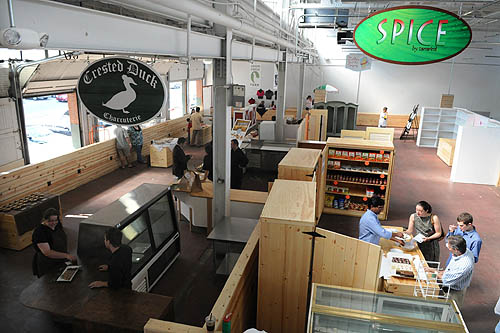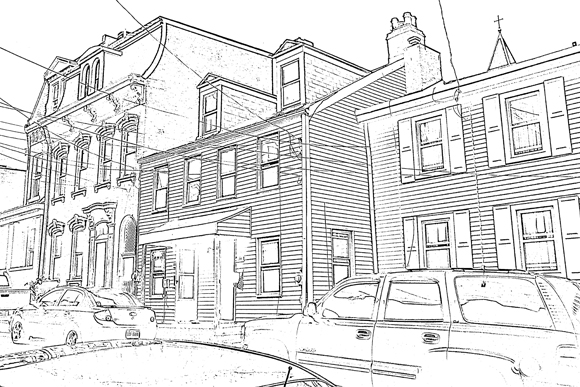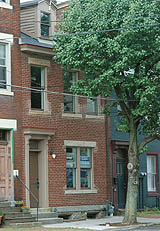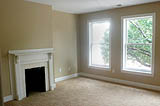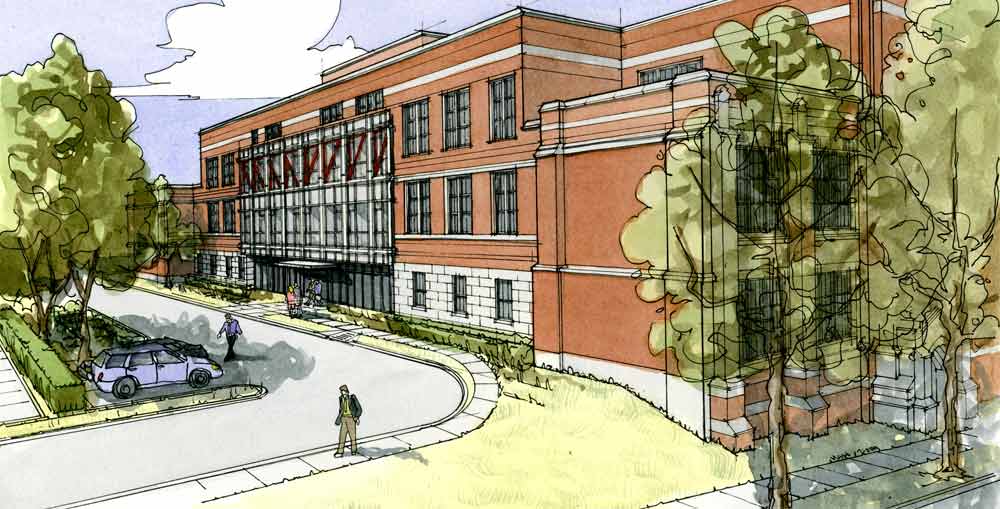
Category Archive: City Living
-
City’s Newest Indoor Market Opens in Strip Next Week
Wednesday, September 01, 2010By Diana Nelson Jones, Pittsburgh Post-GazetteWhen the Pittsburgh Public Market in the Strip opens Friday, patrons will see some tried-and-true faces — La Prima Coffee, the Common Plea and Fudgie Wudgie among them.
But the new indoor market in the Produce Terminal Building on Smallman Street marks the retail debut of a number of the 43 vendors, whose wares will include organic produce, coffee, specialty meats, pastries, Indian food, pierogies, organic teas, local wines, micro brewed beer, skin care products, knitted goods and jewelry.
The Produce Terminal was built in 1926 by the Pennsylvania Railroad. The market house, located between 16th and 17th Streets, features horizontal roof-line skylights and doors that open for a river view. It will be open Fridays from 9 a.m. to 7 p.m., Saturdays from 9 a.m. to 5 p.m. and Sundays from 10 a.m. to 4 p.m. The grand opening festivities are Sept. 10-12.
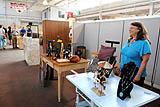
Debbie Jacknin of Jenn's Jems displays her jewelry and other items in her booth at the new Pittsburgh Public Market in the Strip District on Tuesday. Robin Rombach/Post-Gazette
The project began almost nine years ago as a dream of Neighbors in the Strip.
“Eight years, three months and two days,” said Tom Goslin, the Market Council president and owner of American Dispatch.
The dream got state funding in 2005, the same year the Urban Redevelopment Authority, which owns the building, did a feasibility study. The URA invested $100,000. The total price tag of $1.25 million was filled out by federal, state and local foundation money.
“This was part of our neighborhood improvement strategy,” said Becky Rodgers, executive director of Neighbors in the Strip. “It’s been a goal of ours to bring back a piece of history to Pittsburgh.”
The city once had four enclosed marketplaces. The last of them closed in 1965 to create Allegheny Center Mall.
Several years ago, the board of Neighbors in the Strip visited existing markets: the Reading Terminal Market in Philadelphia, the West Side Market in Cleveland and the Central Market in Lancaster, hoping to bring a similar concept to the Strip.
Cindy Cassell, market manager, said the market council selected vendors “in the context of the entire Strip. We had a series of meetings with existing businesses and came up with a list of things that would contribute the most diversity to the Strip.”
Edith Davis and Eartha Sewell, of Edith and Eartha Textiles, are among several woman- and minority-owned businesses in the marketplace. They were in a knitting group, then started knitting together, specializing in scarves and wraps.
“People said they wanted to buy them” said Ms. Sewell, “so we thought we could make a business out of it. Then this opportunity came up. You know what they say: Do what you love.”
The first vendor’s space in the markethouse is Kevin and Adam Costa’s Crested Duck Charcuterie, where the brothers are opening their first specialty meat shop. Kevin was mentored by a chef during a stint in Cincinnati, “then I just played with it and tried things. I did vegan baking at a farmer’s market in Indianapolis” before returning home to Pittsburgh last year.
Debbie Jacknin’s 23-year-old daughter Jenn began making jewelry when she was 14. “She taught me,” said Ms. Jacknin. “We’ve done craft shows before but nothing like this,” their first retail presence — Jenn’s Jems.
“A friend told me about this marketplace. I had to submit a video. And they accepted us.”
Diana Nelson Jones: djones@post-gazette.com or 412-263-1626. -
Public Market in Strip to Open Sept. 10, Feature Specialty Items
By Michael Machosky, PITTSBURGH TRIBUNE-REVIEW
Tuesday, August 31, 2010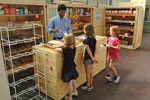
Siblings (from left), Xanthe Schandelmeier, 5; Coco, 9; and Vivienne, 7, of Squirrel Hill, sample sweets at Prasad Potluri's Spice by Tamarind booth in the Pittsburgh Public Market. More than 40 vendors will showcase their wares in a 10,000-square-foot area of the Produce Terminal Building. The grand opening will be Sept.10. The market will be open Fridays, Saturdays and Sundays. Heidi Murrin | Tribune-Review
From homemade pierogies and duck pate with pistachios and fresh herbs to old-school Italian ice and locally-brewed beer — the Pittsburgh Public Market is so close, you can almost taste it.
“It will be 45 years in November since Pittsburgh had a public market,” said Becky Rodgers, executive director of Neighbors in the Strip, who vividly remembers the last one — the long-demolished North Side Market House. “My great uncle Bob was a butcher there. My whole family used to go — it was like a sight-sound-smell extravaganza.”
Starting with a soft opening Friday, the long-delayed Pittsburgh Public Market finally will open to the public. On Sept. 10, there will be a clamorous Grand Opening marked by the ringing of bells — the public is invited to bring their own to add the racket.
Unlike Pittsburgh’s seasonal farmers markets, this indoor market will be open every weekend year-round. The $1.3-milllion project will have more than 40 vendors in 10,000 square feet of space — which is only a small slice of the blocks-long Produce Terminal Building along Smallman Street, where it is housed. The entrance is near 17th Street.
It’s been a delicate balancing act from the start, which began in 2001. Spaces from 6,500 square feet to 30,000 square feet were considered. And finding a way to avoid diverting business from the Strip’s established food purveyors was a major concern.
“You’ll notice we don’t have a fish place in our market — that’s a very usual kind of thing to have in a market,” said Cindy Cassell, the market manager for Neighbors in the Strip. “We don’t have a cheese place. We’re really working hard not to replicate existing niche markets.”
Vendors quite literally are all over the map — from Gosia’s Pierogies to Sito’s Mediteranean dressings, to Ekh’s authentic Indian vegetarian dishes, to Mushrooms for Life, foraged from around Western Pennsylvania.
Kevin Costa was slicing up duck pate and “Gin & Juice Salami” Tuesday morning at the Crested Duck Charcuterie, a specialty meat market with a booth near the entrance.
“We wanted to start our own business, but it would have been impossible to duplicate the foot traffic of the Strip, so this is perfect,” Costa said.
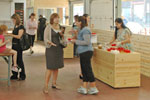
On Sept. 10, the PIttsburgh Public Market will open for business inside the Produce Terminal Building in the Strip District. More than 40 vendors will showcase their wares with everything from baked goods to artwork, barbecues to microbrews. Heidi Murrin | Tribune-Review
Starting a business is a lot less daunting for vendors when they’re paying $25 a day for a 10-foot-by-6-foot booth or $50 a day for a 10-foot-square booth.
“One of our challenges has been to get the concept across that, while this is not necessarily full-time, it’s also not a farmer’s market where you just show up and put your tablecloth down,” Cassell said. “It’s a little more permanent than that. So there is some planning involved for your booth. The booths are small, but from a financial perspective, I think it’s very accessible for a new business.
“We do have a lot of startups that are coming in,” she said. “That’s one of our goals, to incubate new businesses. And you know everything will be realized when they grow up and need a storefront, and can, hopefully, take an empty storefront in the neighborhood.”
Other vendors just want a little more visibility.
The Spice by Tamarind booth stocks Indian spices, snacks, chutneys, ready-to-eat meals and specialties like eggless cakes. Owner Prasad Potluri runs several Indian restaurants and small grocers in the region.
“It’s to make people aware of the restaurants and food,” Potluri said of the reason behind his participation.
For some, it’s simply a way to make it easier for customers to find their product.
Scott Smith, of East End Brewery, always assumed most of the sales for his Big Hop IPA and Black Strap Stout would be wholesale to bars and restaurants. But craft-beer fans just kept searching out the tiny, out-of-the-way brewery.
“We’re in an unmarked building in Homewood, and half our business is walk-in traffic,” Smith said.
Now, customers can sample Fat Gary Nut Brown Ale and Pedal Pale Ale at the Pittsburgh Public Market, and fill up their growlers to take home.
Not everything in the market is edible.
Babouche sells Moroccan crafts, jewelry, scarves and leather goods. Iron Eden is renowned for beautiful ironwork — flowers, trellises, sculpture — often made from recycled scrap metal. Jenn’s Jems features knit and crocheted items, and handmade jewelry.
Markets in other cities — like Cleveland’s West Side Market and Seattle’s Pike Place Market — have become first-day tourist attractions.
The Pittsburgh Public Market is starting on a much smaller scale, of course, but drawing new shoppers to the Strip is part of the plan.
“When we had Campos do a consumer market survey for us in 2006, at that time, we were planning for about 30,000 square feet,” Cassell said. “According to the consumer survey, it would add about 12,000 additional shoppers to the Strip every week. Now we’re scaled back in 10,000 square feet. But one of our goals is to increase the customer base for the entire Strip.”
Pittsburgh Public MarketWhen: Opens Friday, with Grand Opening Festivities Sept. 10-12
Hours: 9 a.m.-7 p.m. Fridays, 9 a.m.-5 p.m. Saturdays, 10 a.m.-4 p.m. Sundays
Where: 17th and Smallman streets, Strip District
Details: 412-281-4505 or website
-
E Properties & Development Restore Abandoned Lawrenceville Houses
Wednesday, September 01, 2010
E Properties and Development is nearing completion on the transformation of two blighted properties on 38th Street in Lawrenceville, contributing to the major revitalization efforts taking place on the hill between Butler Street and Penn Avenue.
The two connected townhouses at 234 38th Street sat neglected for some time, until E Properties and Development principal Emeka Onwugbenu purchased them last June.
“In terms of challenges, people suggested that the properties be demolished,” says Onwugbenu. “Our team of architects and engineers created value-based solutions that would restore the structural stability of each building while building on its architecture.”
Onwugbenu and architect Andrew Moss extended the foundations of the houses to create a more open environment with two added rooms, and installed bamboo floors throughout the buildings. They are also raising the second and third floors, and installing clear story windows, which will allow light to pour through the master bedrooms that will open into unique balcony decks overlooking downtown. The exterior, which is currently composed of vinyl siding, will be swapped out for cement board side material. Coldwell Banker has signed on to market the homes, which will start in the low $200,000 range, and are slated for move-in by Thanksgiving.
Onwugbenu, originally from Nigeria, attended Penn State for industrial engineering, and is currently in his final semester of the MBA program at CMU. He started E Properties and Development in 2007, in order to create unique value-added properties, which mix traditional design with a modern feel.
In addition to the homes at 234 38th Street, architect Andrew Moss is currently building his dream home one block away at 221 38th Street. Two other homes, at 236 and 238 38th Street, are currently being renovated by private owners, within steps of the 234 buildings.
Sign up to receive Pop City each week.
Source: Emeka Onwugbenu, principal of E Properties and Development
Writer: John FarleyImage courtesy Emeka Onwugbenu
-
Regent Square Brick Streets to Remain Brick
Thursday, July 22, 2010By Deborah M. Todd, Pittsburgh Post-GazetteWith parts of the Regent Square neighborhood’s brick-paved Macon and Trevanion avenues in shambles following a recent water main break, residents’ efforts to make sure the street is repaired in its original condition have paid off.
Swissvale council President David Petrarca said the Wilkinsburg-Penn Joint Water Authority agreed Tuesday to repair portions of the streets affected by the water main break with brick, rather than making repairs with asphalt as they had previously requested.
Borough ordinances require anyone excavating or repairing local streets to restore the surface and subbase with the same kind of materials that were originally in place, but the authority requested to repair the street with asphalt to alleviate costs.
“The water authority was very cooperative; we had a cordial meeting and the borough is happy with the agreement we reached. This is the best settlement that could have come out of this,” he said.
Questions about long-term maintenance, plus an offer from the authority to replace Macon Avenue’s waterline with the installation of asphalt, led Swissvale council to hold off on a final decision regarding the road’s repairs during the July 7 legislative meeting. More than 50 residents packed into Swissvale’s council chambers that day to voice objection to the authority’s request.
Neal Harrison of the Regent Square Civic Association outlined the benefits of brick paved streets, such as greater rainwater absorption, no annual repaving and increased property values for homes on brick streets. He also said several cities throughout the country are removing asphalt from bricked roads and renovating the original brick because of long-term maintenance costs.
“We would like to see the brick replaced. There are financial reasons, safety reasons and environmental reasons. The community is an asset and the brick streets are a part of that,” he said.
Mr. Harrison estimated replacing the brick road using existing materials will cost the authority about $81,000 compared to an approximately $90,000 estimate for the cost of asphalt.
However, Wilkinsburg-Penn Joint Water Authority executive director Anthony Russo Jr. said the agency’s engineer’s report estimated a total cost of $475,000 to repair the street with brick and replace water and service lines. The report said making the same repairs with asphalt would cost about $250,000 and it is unlikely the company’s insurance will cover the costs of restoring a brick street.
The report also noted that the authority’s repairs would fix only damage from the water main break, not repair the entire road.
“Macon Avenue is 30 feet wide and 640 feet long. It should be noted that repairing only the areas where it is evident that the damage was caused by the water break will not produce a consistent cross section and/or eliminate the wavy appearance of the street,” it reads.
Mr. Petrarca said the parties agreed during Tuesday’s meeting to have each of their engineers examine the damaged streets to determine exactly which portions will be repaired by the water company this month. However, the authority has not committed to installing a new waterline on Macon Avenue under the new agreement.
Mr. Petrarca said the borough does not have plans to repair portions of the road that weren’t damaged by the water main break, but said the road will be back in working condition once the authority’s repairs are made.
The borough is preparing a letter detailing results of the meeting to be read during its July 28 meeting.
-
Buying Here: Deutschtown
Saturday, July 17, 2010By Kevin Kirkland, Pittsburgh Post-GazetteEven by North Side standards, 621 Tripoli St. was a challenge.
The original 1890s brick townhouse was intact, but the later wood-frame addition on the back was crumbling and falling away, and raccoons had made themselves at home. Worst of all to an old-house lover, someone had cut into the front facade and installed a picture window, probably in the 1970s.
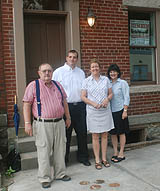
Members of the Northside Leadership Conference, from left, are Bernard Beck, president of East Allegheny Community Council; Greg Jones; Nancy Noszka, director of real estate for the Northside Leadership Conference; and Teekie Smith, Coldwell-Banker agent. Larry Roberts/Post-Gazette
The window is history now, as is the early 20th-century addition, replaced by a new wood-frame rear section containing the kitchen, part of the dining room and a second-floor bedroom. The two-bedroom, 11/2-bath house is on the market for $219,900 through Teekie Smith of Coldwell Banker Real Estate’s Shadyside office (412-708-1588 or www.pittsburghmoves.com, MLS No. 826966).
Ms. Smith says the house is a perfect blend of old character and new amenities.
 Deutschtown:
Deutschtown:
At a glance- Website: www.deutschtown.org
- Size: .236 square miles
- Population: 2,635 (2000 census)
- School district: Pittsburgh Public, www.pghboe.net
- Enrollment: about 28,000
- Average SAT scores: 358 verbal; 383 math; 362 writing (2009, Oliver High School)
- Taxes for a house assessed at $100,000: $2,941; County: $469 (4.69 mills); City: $1,080 (10.8 mills); School: $1,392 (13.92 mills)
- Wage tax: 3 percent (1 percent to the city, and 2 percent to the school district)
- A bit of history: Deutschtown — also known as East Allegheny and Dutchtown — dates back to the mid-1800s and grew as the City of Allegheny expanded eastward. As its name implies, it was once the heart of Pittsburgh’s German-speaking community. It is still headquarters for the 150-year-old Teutonia Maennerchor, the largest German singing society and social club in the region. The neighborhood was added to the National Register of Historic Places in 1983.
“The developers have tried their hardest to preserve anything original,” she said. “The hardware is wonderful. There are locks and latches that I’ve never seen before. But it’s also got new floors, air conditioning, a second-floor laundry, off-street parking [two spaces] and a big backyard.”
This is the fifth project in the past 10-15 years involving the Northside Leadership Conference and East Allegheny Community Council, says Greg Jones, project manager for the Northside Leadership Conference. Al Depasquale and October Development were the general contractors on this renovation and another at 517 Tripoli. Mr. Depasquale is also the developer and contractor on three new houses going up around the corner on James Street.
In late 2008 and early 2009, October Development finished building three new brick houses and renovating two old ones in the 900 block of James. The three new townhouses sold for $229,000 each and the old ones for $190,000 and $165,000, respectively.
“The new ones sold before construction,” Mr. Jones noted. “The speed and price were unprecedented in this area.”
This part of the North Side is usually called East Allegheny or Historic Deutschtown in recognition of its large German population in the late 19th century. It was divided by construction of the Parkway North in the 1980s. Many century-old brick townhouses remain, along with more modest wood-frame dwellings. Some have been renovated, but not as many as in nearby Allegheny West and the Mexican War Streets, where houses are generally more expensive.
Mr. Jones said buyers are fairly evenly divided between young professionals and older empty-nesters, many of whom are familiar with the North Side and its historic yet affordable housing stock.
“They say, ‘My friend bought one in this neighborhood.’ It’s a limited supply but a heck of a market. They often sell by word of mouth,” he said.
“These people have an interest in historic restoration. They know what they’re getting into. They get a house with some character that has a story to it.”
Adding to the attraction is a 10-year abatement on city and school property taxes and a three-year abatement on county taxes that can save buyers as much as $30,000 to $40,000, he said. Depending upon income, they may also qualify for a second, deferred mortgage, Ms. Smith said.
The home at 621 Tripoli is unusual in that it was renovated with no public subsidy through funding from the Northside Community Development Fund. The design/build process used reduced the need for an architect and sped construction. Luckily, many of the old doors and much of the hardware and trim were reusable, as was the original staircase and mantels on the two decorative fireplaces. Preservation expert Nick Kyriazi, a longtime member of the East Allegheny Community Council, even came up with old lighting fixtures for the first floor.
“They were restored and rewired. They’re stunning,” Ms. Smith said.
Although the front parlor and floor plan were retained, the new rear section is very open, with granite countertops in the new 13-by-13-foot kitchen. The new powder room is tucked away nearby, and the large modern bathroom upstairs serves bedrooms measuring 17 by 15 feet and 17 by 13 feet, respectively, each with large closets. The developers opted to make the third floor a storage area rather than living space (the ceiling height is only about 6 feet).
The East Allegheny Community Council bought the property for $9,900 in June 2008, and its assessed market value is $9,000 (www2.county.allegheny.pa.us). Five properties have sold on Tripoli in the past three years for prices ranging from $17,500 in July 2009 to $215,000 in September 2009 for the October Development rehab at 517 Tripoli. One property sold twice (www.realstats.net).
This house is three blocks away from Allegheny General Hospital and Allegheny Commons Park and 5-10 minutes waking distance from Downtown, Heinz Field and PNC Park. An open house will be held from 1 to 4 p.m. this Sunday and next Sunday.
-
Neighbors in the Strip Accredited as a National Main Street Program
Wednesday, July 21, 2010
Pop City Media
Neighbors in the Strip, a non-profit organization dedicated to promoting economic development in the Strip District, has been awarded designation as an accredited National Main Street Program by the National Trust for Historic Preservation.
The prestigious designation is based on a ten point set of criteria, which ultimately demonstrates that an organization has leveraged local historic and business assets to thoroughly promote revitalization of a neighborhood business district.
Neighbors in the Strip was formed in 1999 by stakeholders wishing to better promote economic transformation in the neighborhood, while maintaining its historic character. A decade ago, “the perception of crime in the strip was very high,” notes Becky Rodgers, Executive Director of NITS. “Looking back over the past ten years, with a lot of hard work from the police, the DA’s office, and the stakeholders, crime has decreased in the Strip by 58 percent. If you want to keep economic development happening, you have to keep crime down.”
In addition to making the neighborhood safer, NITS works with local proprietors to promote business. In fact, forty new businesses are scheduled to open soon, including a public market, which will be opening in August.
“We’re mainly zoned urban-industrial in the Strip, which is sort of the wild west of zoning,” says Becky. “So when a new project comes along, there are certain zoning exceptions that have to go in front of the zoning board, and we go with business owners to the board to support those variances.”
Other factors that lead to the Main Street designation include NITS’ strong cooperation with its partners, which include the City, the URA, and a large number of non-profits, as well as the substantial grant programs they offer. Neighbors in the Strip has played a key role in helping the neighborhood evolve into a residential area in the 2000’s, aided by their Upper Floor Grant, which encourages the residential development of underutilized floors above commercial businesses.
Sign up to receive Pop City each week.
Source: Becky Rodgers, Executive Director of Neighbors in the Strip
Writer: John Farley -
Old School Steps to Front of the Class
By Eric Heyl
PITTSBURGH TRIBUNE-REVIEW
Wednesday, July 21, 2010Consider it a textbook example of how to transform a dilapidated eyesore into a potential community jewel.
For nearly a quarter-century, the former South Hills High School in Mt. Washington slowly deteriorated while various redevelopment proposals were about as successful as the initial Hindenburg launch.
As recently as 18 months ago, the enormous 155,000-square foot building occupying an entire city block at the corner of Ruth and Eureka streets stood empty and decaying.
Surrounded by an imposing chain link fence, the old school appeared as though it never would be anything more than a refuge for birds seeking shelter through the holes in the roof.
Since then, the scene has changed dramatically.
“We’ve come a long way,” Victor Rodriguez said Tuesday, standing in the vicinity of where the principal’s office used to be. “I think this is pretty monumental in terms of what we’ve accomplished.”
Rodriguez is senior vice president of a.m. Rodriguez Associates, which purchased the building from the city’s Urban Redevelopment Authority two years ago for $1. Given the structure’s condition at the time, Rodriguez might have overpaid for it.
But following a $23 million makeover that included $10 million in public money, the structure will reopen in about six weeks as the South Hills Retirement Residence.
The place is proving popular among the senior crowd even before the first tenants move in. As contractors scurry to apply the finishing touches, 42 of the building’s 106 units have been leased.
Rodriguez yesterday provided me a tour of the building, the inside of which looks virtually nothing like it did when the Class of ’86 closed the school for good.
Although some of the original hardwood and ornate metal railings were incorporated into the interior design, it’s unlikely the 2,200 members of the school’s alumni association would recognize the place.
That’s a good thing.
Rodriguez removed several unsalvageable portions of the former school, including the auditorium and the swimming pool, while adding amenities the 94-year-old building desperately needed — elevators and air conditioning.
In addition, a portion of the building is expected to house medical offices, which should further increase foot traffic in what had become a desolate neighborhood. An early childhood development center also might occupy some space.
“What we’re striving for here is something community-changing,” Rodriguez said.
Joshua “J.T.” Smith, board president of the Mt. Washington Community Development Corp., lives about two blocks away and is thrilled with how the place looks.
“For years, that building created a real negative mood with all of that prison-style fencing around it,” he said. “It’s great to walk by now and see something vibrant and alive, with the new trees and the clean sidewalks. This is going to alter the mentality of the whole neighborhood.”
Again, it’s a textbook example of transformation.
For an old school, what could be more appropriate?
-
Firms Pitch Building Plans for Garden Theater Area
By Bill Vidonic
PITTSBURGH TRIBUNE-REVIEW
Tuesday, July 20, 2010The owner of a central North Side business only wanted to hear one issue addressed Monday about the redevelopment of the block surrounding the vacant Garden Theater.
“Parking, parking, parking,” said Irene Karavolos, co-owner of Steve’s New York Hot Dogs on Federal Street. “You can’t bring in more businesses when little businesses already are starving for parking.”
More than 200 people crowded into an auditorium at the Children’s Museum of Pittsburgh to hear several proposals for the block surrounding the former X-rated theater, with five developers promising to spend tens of millions of dollars to revitalize the blighted section of the North Side.
All submitted proposals calling for a mix of retail and residential development; two called for the partial or complete destruction of the vacant Garden Theater auditorium.
Kirk Burkley, president of Northside Tomorrow, which is coordinating redevelopment efforts, said the Garden wouldn’t vanish entirely under any of the proposals. City and national historical designations mean the building’s facade must be preserved.
“This project affects more than just the central North Side,” Burkley said.
North Side resident Matt Long said he’d like to see the Garden restored as an independent filmhouse.
“I don’t think retail would be what I’d put there,” Long said.
Tom Hardy, a consultant with Northside Tomorrow, said a decision could come in the next couple of months.
“We have some momentum now,” Hardy said. “There’s an interest in keeping that momentum going.”
North Side visionsDevelopment proposals for the Garden Theater block:
• Barron Commercial Real Estate, Pittsburgh: Demolish the former Garden Theater auditorium, but preserve and restore the remaining historic properties into a mix of housing and retail development.
• Wells and Company, Spokane, Wash.: Restore the Garden Theater auditorium for a performing arts center; build apartments in the former Masonic building, along with a first-floor restaurant/brew pub; and restore buildings along West North Avenue and Reddour Street.
• Zukin Development Corp., Philadelphia: Create retail space, including a specialty grocery store, by demolishing part of the Garden Theater; create retail space and apartments in the Masonic Hall, the Bradberry apartment building and other properties.
• Aaron Stubna and William Porco, Coraopolis: Convert the Garden into a multi-purpose theater hosting live entertainment and films.
• Resaca LLC, Pittsburgh: Redevelop the Bradberry into 16 one-bedroom apartments.
Source: Northside Tomorrow LLC

